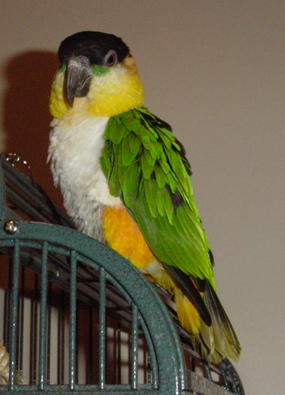- Black-headed Parrot
Taxobox
name = Black-headed Parrot

status = LC | status_system = IUCN3.1
regnum =Animalia
phylum =Chordata
classis =Aves
ordo =Psittaciformes
familia =Psittacidae
subfamilia =Psittacinae
tribus = Arini
genus = "Pionites"
species = "P. melanocephalus"
binomial = "Pionites melanocephalus"
binomial_authority = (Linnaeus, 1758)
synonyms = "Pionites melanocephala"The Black-headed Parrot ("Pionites melanocephalus"; sometimes incorrectly "Pionites melanocephala"), also known as the Black-headed Caique, Black-capped Parrot or Pallid Parrot (for "P. m. pallidus"), is one of the two species in the genus "
Pionites " of thePsittacidae family; the other species being theallopatric White-bellied Parrot .It is found in forest (especially, but not exclusively, humid) and nearby wooded habitats in the Amazon north of the
Amazon River and west of theUcayali River inBrazil ,Colombia ,Ecuador ,French Guiana ,Guyana ,Peru ,Suriname , andVenezuela . It is generally fairly common and occurs in many protected areas throughout its range.It is a medium-small, short-tailed parrot with a black crown, yellow to orange head, whitish belly, yellow thighs and crissum, green back, wings and upper tail, blue primaries (blackish from below), and greyish-black bill and feet.
It is most often found in pairs or small noisy flocks of up to 10 individuals, but sometimes up to 30. In the wild, they eat mostly flowers, pulp, and seeds and possibly insects.
Male and female birds look identical.
ubspecies
There are two
subspecies of the Black-headed Parrot. Theyhybridize freely and individuals showing some level of intermediacy in color are common:* "P. m. melanocephalus": Eastern part of its range. Orange thighs and crissum, nape deep orange, and belly white.
* "P. m. pallidus": Western part of its range. Yellow thighs and crissum, nape relatively pale, and belly tinged yellowish (often barely visible; belly normally appears "dirty white" in the wild).Juveniles of both subspecies are strongly tinged yellow below.
Aviculture
Black-headed Parrots are popular in
aviculture .The only ways to determine gender of an individual Black-headed Parrot are surgical sexing and
DNA sexing. DNA sexing is safer for the bird than surgical sexing.Gallery
References
* BirdLife International 2004. [http://www.iucnredlist.org/search/details.php/48084/all Pionites melanocephalus] . [http://www.iucnredlist.org 2006 IUCN Red List of Threatened Species. ] Downloaded on 24 July 2007.
* Collar, N. (1997). "Pionites melanocephala" (Black-capped Parrot). Pp. 457 in: del Hoyo, J., Elliott, A., & Sargatal, J. eds (1997). "Handbook of the Birds of the World." Vol. 4. Sangrouse to Cuckoos. Lynx Edicions, Barcelona. ISBN 84-87334-22-9
* Parr, M., & Juniper, T. (1998). "A Guide to the Parrots of the World". Pica Press, East Sussex. ISBN 1-873403-40-2
* Restall, R., Rodner, C., & Lentino, M. (2006). "Birds of Northern South America". Vol. 1 & 2. Helm, London. ISBN 0-7136-7242-0 (vol. 1); ISBN 0-7136-7243-9 (vol. 2)
* Ridgely, R., & Greenfield, P. (2001). "The Birds of Ecuador - Field Guide". Cornell University Press. ISBN 0-8014-8721-8
* Schulenberg, T., Stotz, D. Lane, D., O'Neill, J, & Parker, T. (2007). "Birds of Peru". Helm, London. ISBN 978-0-7136-8673-9
* Sigrist, T. (2006). "Aves do Brasil - Uma Visão Artistica". ISBN 85-905074-1-6
Wikimedia Foundation. 2010.
